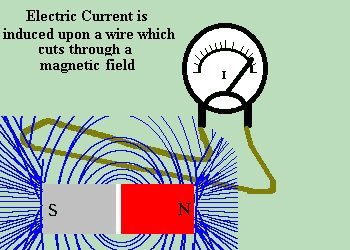


Magnetic Induction - The Flip Side previously, we discussed the fact that a wire conducting an electric current, generates a magnetic field around it. Along the same lines, when a magnetic field, radiating from a permanent magnet, passes through a wire or coil of wire, it induces an electrical current on the wire. To state this another way, just as a current in a wire generates a magnetic field - a magnetic field passing through a wire generates a current.
previously, we discussed the fact that a wire conducting an electric current, generates a magnetic field around it. Along the same lines, when a magnetic field, radiating from a permanent magnet, passes through a wire or coil of wire, it induces an electrical current on the wire. To state this another way, just as a current in a wire generates a magnetic field - a magnetic field passing through a wire generates a current.We can monitor this action by placing a meter across the wire. When we approach a wire with a magnet, the wire cuts the magnetic field and we see the meter needle move. In this way, we can "generate" electricity by moving a magnet in close proximity to a wire. The stronger the magnetic field, the more current flows through the wire. There is a catch though. If we stop the movement of the wire, right in the middle of the field, one would think that electrical current would continue to be generated. Actually, this is not the case. The magnetic field must be moving in relation to the wire in order for a current to be generated in the wire. In other words, either the magnet, or the wire must be moving. And the faster the wire passes through the field, the more current is generated. Now we know that according to the physical law of CONSERVATION OF ENERGY that no energy is ever lost or gained. So the energy generated in the wire can't just come out of the blue. It must be transformed from some other sort of energy. The question being, does it come from the magnetic field, or from the motion? The answer is that the energy is transformed from mechanical momentum into electrical current.  This is the principle behind an electric generator. If we take a wire coil, and place it on a rotating shaft, then we can spin the coil. If the shaft runs midway between two permanent magnets, we can control the movement of a coil of wire between two magnetic poles. Thus, it is possible to generate electricity by spinning the coil upon the shaft, because the wire is in constant motion within the magnetic field. The motion is transformed into electricity via the magnets. The electricity goes out to the world from the terminals, by way of the brushes and slip rings. This will be explained in more detail in a later lesson. The important point to remember is that we can generate magnetism with a wire conducting electricity, and we can generate electricity with magnets.
This is the principle behind an electric generator. If we take a wire coil, and place it on a rotating shaft, then we can spin the coil. If the shaft runs midway between two permanent magnets, we can control the movement of a coil of wire between two magnetic poles. Thus, it is possible to generate electricity by spinning the coil upon the shaft, because the wire is in constant motion within the magnetic field. The motion is transformed into electricity via the magnets. The electricity goes out to the world from the terminals, by way of the brushes and slip rings. This will be explained in more detail in a later lesson. The important point to remember is that we can generate magnetism with a wire conducting electricity, and we can generate electricity with magnets.
|
| (On The Following Indicator... PURPLE will indicate your current location) | ||||||||||||||||||||||||
| 1 | 2 | 3 | 4 | 5 | 6 | 7 | 8 | 9 | 10 | 11 | 12 | 13 | 14 | 15 | 16 | 17 | 18 | 19 | 20 | 21 | 22 | 23 | 24 | 25 |
| 26 | 27 | 28 | 29 | 30 | 31 | 32 | 33 | 34 | 35 | 36 | 37 | 38 | 39 | 40 | 41 | 42 | 43 | 44 | 45 | 46 | 47 | 48 | 49 | 50 |
| 51 | 52 | 53 | 54 | 55 | 56 | 57 | 58 | 59 | 60 | 61 | 62 | 63 | 64 | 65 | 66 | 67 | 68 | 69 | 70 | 71 | 72 | 73 | 74 | 75 |
| Otherwise - please click to visit an advertiser so they know you saw their ad! |
